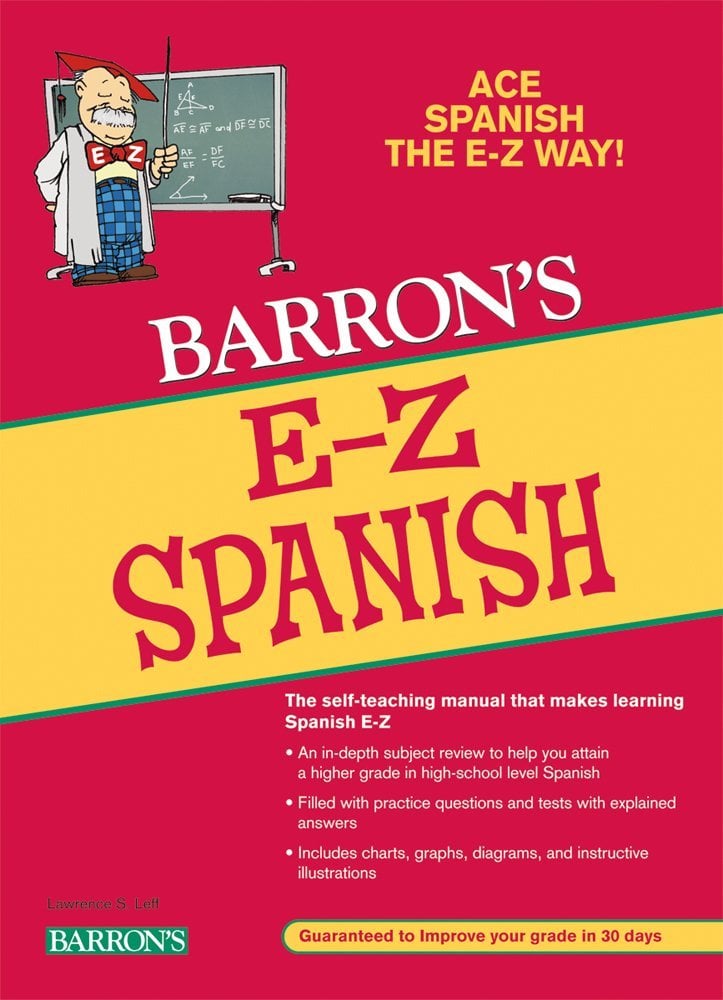Barron's E-Z Spanish is the latest update for Spanish in the publisher's series of introductory textbooks previously known as The Easy Way. While the original Spanish: The Easy Way came out in 1982, make no mistake that the authors have put in the effort to make this a modern textbook. There is definitely a lot that could be improved upon with this course, but I think it has merits that could make it a great supplementary material for beginning Spanish learners.
The textbook is made up of 34 main units and two supplementary sections, with all the standard glossaries and indexes at the back of the book. Each unit has a dialogue and/or narrative at the beginning of the lesson, followed by exercises, some grammar explanations, and more exercises. Flipping through the book, you can tell that the content of the book is primarily made up of exercises. I wouldn't say that having a lot of exercises is necessarily a bad thing, but the lack of ample reading passages doesn't really give students a good balance of input to output. On the other hand, the book is well-formatted and visually appealing, using a mix of red and black text to provide contrast. There isn't much wasted space and the artwork is simple, yet relevant.
One thing that is odd about this text is that it doesn't come with any audio materials. There is no CD or DVD included, and there is nothing you can access online to listen to the content of this book. While I think it is a little easier to get by without any audio recordings when studying a language like Spanish, which is very close to English, I still find it a little odd that the publishers have not provided anything for students to practice this modality.
The main strengths of this book are the dialogues and narratives that are featured at the beginning of each unit. I can honestly say that I laughed out loud when I read the majority of these passages. These are not your typical language textbook passages – it is clear that the authors decided to teach through humor, and they have been greatly successful in doing so. I think that most students will probably find these passages entertaining, but some of the content may not be appropriate for students younger than high school age. There is plenty of content covering modern topics such as computers, the internet, and technology. For the most part I feel like the dialogues are put together using natural speech, as opposed to the choppy, forced interactions that are found in many introductory textbooks. Some of the interactions are definitely exaggerated and/or melodramatic, but I think this serves to make the content and vocabulary more memorable.
"The main strengths of this book are the dialogues and narratives that are featured at the beginning of each unit. I can honestly say that I laughed out loud when I read the majority of these passages."
Vocabulary directly follows the reading passage, organized alphabetically by parts of speech. The list is always on the same page as the passage or the one directly following it, which is convenient, but the way the terms are organized can sometimes make it hard to find the particular term you are looking for. New verbs are given only in the dictionary form, not necessarily how they appear in the passage, which can be somewhat of an inconvenience. Students that can't find the term they are looking for can always use the glossary, but it would have been nice to have some more user-friendly vocabulary lists.
The exercises vary in both quality and quantity from lesson to lesson. There is a wide variety of exercises throughout the text – some are great and others not. I would advise students and teachers to pick out only the exercises they find interesting or useful, skipping over the rest. Answers to the exercises are provided at the back of the book, but the key can be a little hard to navigate at times, as there are no references to page numbers. Overall, I think there are plenty of good exercises for students to practice with, but the book could have benefited from taking out the less practical drills, and offering a more consistent structure throughout the lessons.
I feel a bit conflicted about the treatment of grammar in this book. While I think that the explanations and examples themselves sufficiently cover all the relevant grammatical topics, there is a problem with the order in which things are presented. It seems like the authors really wanted to avoid teaching too much grammar at once. I understand that it would make for a dry textbook if one tried to cover too much grammar in any given unit, but the amount of grammar taught per lesson is far too minimal. Not only does this mean that grammar sections don't cover all the new grammar that was used in the reading passages, it means that many elementary topics aren't encountered until much later in the textbook. For example, students are not taught the differences between estar and ser until the eleventh unit, page 125. I think that this is something that beginning Spanish students should begin learning in their first week of study, so it seems really inappropriate to put this so far into the book. This means that instructors choosing to use this course will need to either be using it as a supplementary aid only, or to go through the course beforehand and identify the order that students should progress through the course. Students using the text outside of the classroom can reference the index and verb reference charts if they want to get clarification for grammar as they are working through the book, but students by themselves will probably not know the best way to work through the course.

The two extra sections in the book – one coming at the beginning and one at the end – seem like afterthoughts. It isn't exactly clear how or when (what part of the course) students are supposed to go about working through these sections. The section at the beginning is made up of a bunch of random exercises, and the section at the end contains mini-dialogues, idioms, and more exercises. I guess there is some use that students could get out of going over these sections if they could figure out which exercises correlate well with which lessons from the main units in the book, but I felt these sections could just as easily be skipped entirely.
As I suggested at the beginning of this review – this book is a mixed bag. It could use more in terms of passages, but there are plenty of good exercises, and the grammar explanations are solid, albeit poorly organized. The course has a lot of weaknesses if you are considering it as a primary coursebook, but can offer a lot to make your average Spanish course a lot more interesting. The authors of this book have succeeded in making passages which are genuinely interesting and entertaining, perhaps the most difficult and rarely achieved aspect of any successful language course. It may not seem like much when compared to the questionable pedagogical strategies of the book, but adding this little “spice” into learning can make a huge difference. It has the power to make students more motivated and enthusiastic about learning Spanish and truly wanting to understand the language, and I highly recommend including this book in all introductory Spanish courses.




